Graffiti Graveyard
Chris Godsey explores the richest trove of graffiti in the north. Is it public art?
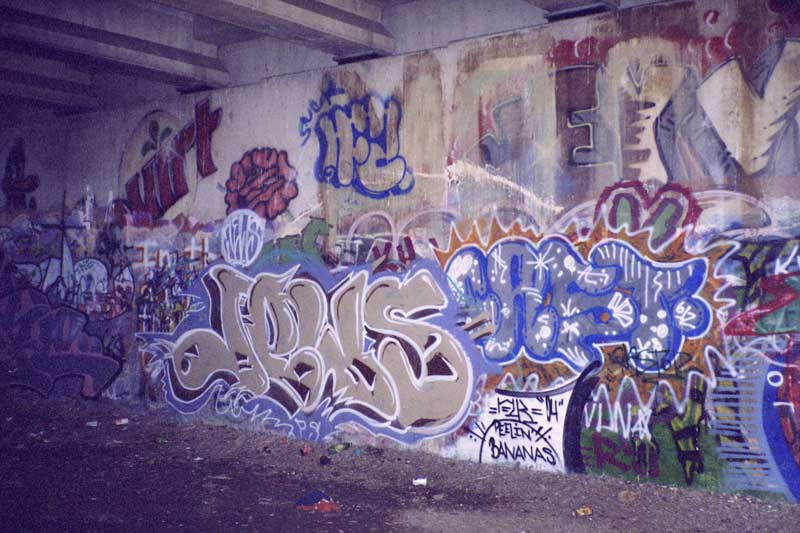
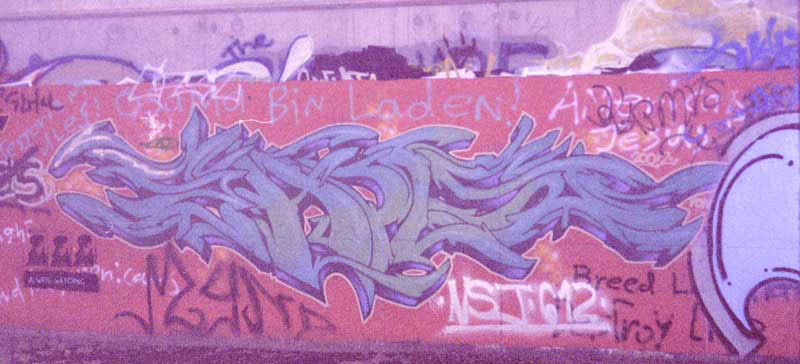
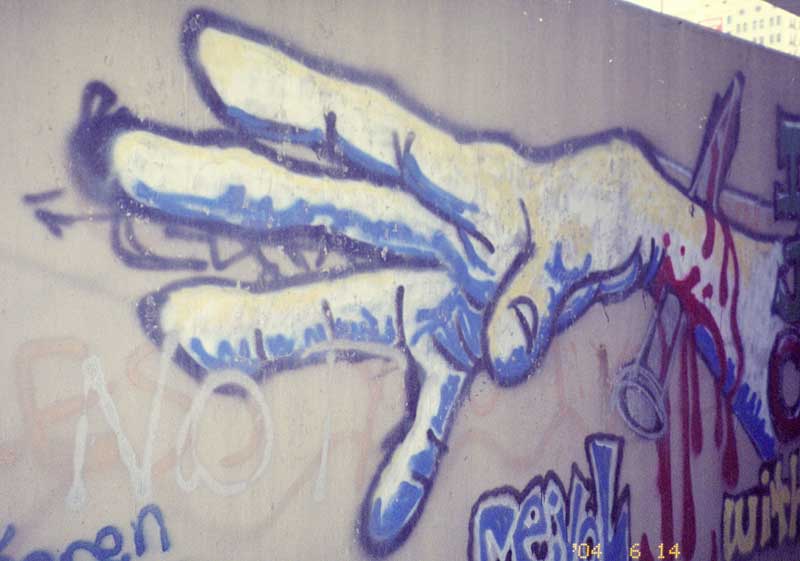
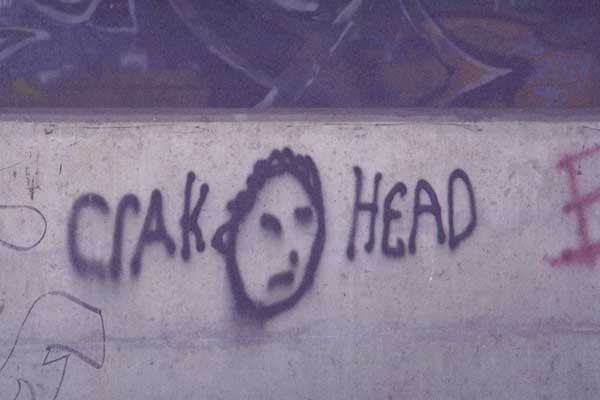
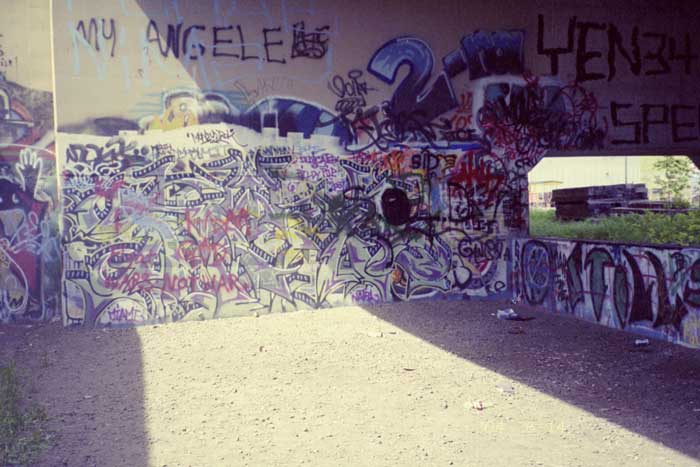
Under the highway that shepherds tourists in and out of Duluth, squalor and inspiration coexist among art most people will never see.
The Graffiti Graveyard, a quarter-mile stretch of filth and creativity, lies under Interstate 35, just half a mile west from tourist mecca Canal Park, and quite close to the Depot (an arts center and museum). The Graveyard offers a stunning correction to the illusion, even believed by many Duluthians, that this city is a small town, with all the quaintness such a characterization would suggest.
It’s one of Duluth’s creepy places, the Graveyard. Getting there requires taking a frontage road toward a grim industrial area, crossing a train track—on foot, now–scrambling through 30 feet of jagged rocks the size of grapefruit, hoping to avoid an urban “stream” that looks and smells like it’ll give you typhus, polio, and cholera, then balancing, in the stream, on an old packing pallet and boosting yourself onto and over a ledge painted with pigeon crap.
Now you’re in a filthy, sub-freeway cave—maybe 80 yards across, 30 feet high–with a sunroof. Sunlight falls between the north and south lanes of I-35—the space between them bisects the overhead length of the graveyard. The water you probably got sick while crossing divides the ground for 20 or 30 yards, then abruptly stops, uniting the sides of the cave. As you walk east (which often feels like north in Duluth), away from the entrance, the Graveyard gets much more narrow and shallow. When you enter, the bottom of the freeway provides a 10- or 12-foot ceiling, so the Graveyard’s first few caverns, separated by huge concrete support joists and pillars, feel like enormous concrete halls. The further east—or into the depths of the graveyard–you go, the more the ceilings drop, till at the Graveyard’s terminus, you’d have to get down on all fours to reach each cavern’s back wall; a grim prospect. The ground is nothing but dirt and the type of trash that collects in a city’s ignored spaces. Tough weed scraps eke out life where sunlight hits. Otherwise, spent spray paint cans, soda bottles filled with indeterminate liquids, single discarded shoes and gloves, and other dark, depressing objects rest in the dirt.
Just walking past the cavern openings, even on a bright June afternoon, raises goose bumps and the certainty that your ankle will be grabbed by someone or something who’s displeased by your presence. Only 10 or 12 feet separate the walls of the Graveyard at this point, and you’ll feel like moving quickly back to the entrance, where you’re more in the open, the passing traffic isn’t as close and doesn’t seem so violent, and where your mind can’t play tricks about what might be hiding in filthy, dark spaces.
Two powers rule the Graveyard: graffiti and filth. None of the synonyms provided by Microsoft Word (“dirt, grime, rubbish, refuse, soil, waste, muck, debris, smut”) work as well as “filth” to convey the damp sensation of organic scum and man-made trash that morphs into an intangible, uncomfortable sensation, leaves you itchy and on the verge of dry heaves. Such filth overloads all senses, even taste. If you’re lucky enough to live in a clean world, your hands and feet will feel unclean for days; you’ll hope you don’t suddenly recall the sensory experience while eating.
Graffiti covers every vertical surface and is mostly written by wanna-be taggers who can only mimic creativity or talent. Some pieces’ astonishing swirls and angles seem three-dimensional, like they’re floating above the place’s permeating scum. Sometimes turnover is frequent, and the frustration of seeing a masterpiece covered by crap is mitigated by multiple new masterpieces. Sometimes there’s no change for weeks, and as skillful works fade, the sprayed profanity, misspelled declarations, and other old standbys—usually too physically inaccessible to replace—creep back into prominence.
Early this summer, the best Graveyard graffiti featured everything from angular electric blue letters with silver borders to pillowy green and yellow writing that looked like it might taste good on a hot day. An illustrated hip-hop kid with exaggerated baggy pants and cap pulled low hung out on the edges of a red and blue cityscape. Scrawled over every impressive piece was a single, small tag, just big enough to ruin the major work; territorial pissing with spray paint.
And hanging along a ledge were four or five sleeping bags, some pants, and a few sweatshirts. More bags were spread on the ground, next to a couple backpacks and pairs of shoes. No people showed themselves, but a few were obviously staying there. Cars and trucks constantly hummed overhead. Every now and then, the concrete palpably flexed, and the ground shook. It seemed like a rat or two should scuttle by, but none did.
Only the spray-painted words moved, in their places on the walls. Like spirits in any graveyard or diaphanous creatures in a real cave, they live in darkness and mystery, with vitality and beauty beyond description.